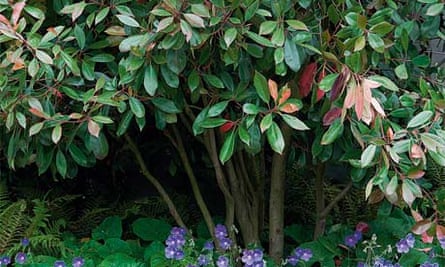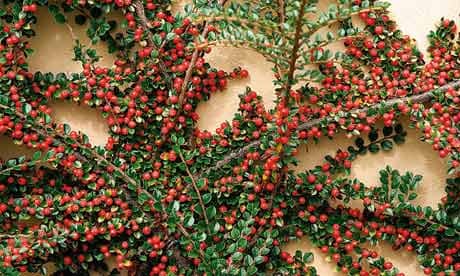Some plants, such as Ammi majus, are on-trend. Others, such as roses, are classics. But some unlucky characters – cotoneaster, pyracantha and privet, say – are deemed dull. That's a shame, because they're inexpensive, reliable and not without merit. So why aren't they fashionable?
They're victims of their own success. It's precisely because they're cheap and reliable that we took to them years ago, and they've since been used here, there and everywhere. And widespread use can sound the death knell for popularity. The tree fern is a classic example: in the late 1990s, it was the must-have plant, but a few years later its popularity had evaporated. Nobody wants a garden design cliché.
Yet they can be reinvented. Designer Tom Stuart-Smith did this with his 2006 Chelsea show garden, when he took a risk with the evergreen shrub leatherleaf viburnum (Viburnum rhytidophyllum), trimming off the side shoots from its lower branches to leave a network of angular stems topped with a mop of leaves – a technique known as crown lifting. The dramatic effect won him best in show. All of a sudden, leatherleaf viburnum was hot.
I suspect many of us have plants that have fallen out of fashion. Here are a few ways to sex them up.
Crown lifting
This works especially well on broad-leaf evergreen shrubs that are clothed down to the floor. It's a bit like a cancan dancer hitching up her skirt to show off her legs. Trim the shoots in late autumn or early spring, before the sap starts to flow. But don't get carried away. Stand back often to check you're not overdoing it – you want to lift the skirt only about a third of the way up. Plants with hidden attributes are also good candidates for this. The flowers of Elaeagnus x ebbingei 'Gilt Edge' are hidden under its leaves, so they normally go unnoticed, but they have a delicious fragrance.
It also works on plants with colourful or interesting bark; the strawberry tree (Arbutus unedo), with its rich, earthy red bark, is a good example. Large-leaved shrubs such as Photinia x fraseri 'Red Robin' and Pittosporum tenuifolium also look great when crown-lifted.

Cloud pruning
This is nothing short of alchemy. It can turn a big, clumsy oaf such as pyracantha, cotoneaster or leylandii into something cool. As the name suggests, you trim the whole plant (and it must be quite large already) into a freestyle shape resembling a series of fluffy clouds. If pyracantha and cotoneaster are trimmed in early spring, the autumn berries will hug the cloud's contours, enhancing the effect. Cloud pruning works on pretty much anything with small evergreen leaves.
Grouping
Garden design aficionados, look away now: pampas grass (Cortaderia selloana) can look cool. The reason it's so unfashionable is that you only ever see it planted on its own. It's a flowering grass and needs to be surrounded by swaths of flowering perennials and other grasses. If you have space, try three or five in a group surrounded by their friends; you'll find they fit right in. After all, would Verbena bonariensis, Stipa tenuissima or Miscanthus sinensis be anywhere near as popular if they were only ever grown on their own in the middle of a lawn?
Not pruning
Knowing when to put down the secateurs is as vital as knowing how to prune. Plants such as magnolias and the common broom cytisus look best as nature intended. Pruning spoils their shape. Most surprising of these "non-pruners" is privet (Ligustrum ovalifolium), which is rarely left untrimmed. The first time I saw one, it had a relaxed, natural shape, was smothered in lovely white flowers and alive with bees. I had to look twice before I worked out what it was. It'll grow to about 4m high, so give it some room.
Fan training
Cotoneaster horizontalis was intended to be grown along the ground, which is where you usually see it. But this doesn't do it justice. Its architectural look is lost when it's scrabbling around in the mud. Grow it up a wall or fence and it comes alive. Each branch has a dominant backbone with symmetrical side shoots. Growing it vertically also negates the fuss of training: gravity does the work and it naturally forms a fan shape. It isn't worried by pests or diseases, is happy in the shade and will reward you with white flowers, red berries and great autumn leaf colour.
Fan training also works well on the sweet-smelling evergreen Carpenteria californica, transforming it into something rather special.

Comments (…)
Sign in or create your Guardian account to join the discussion